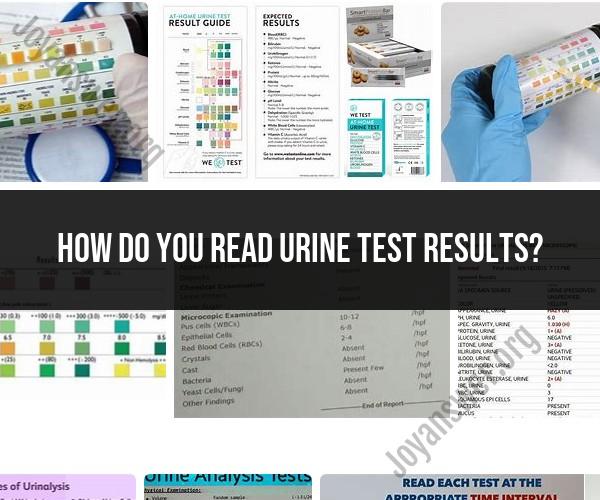How do you read urine test results?
Interpreting urine test results involves understanding the values and measurements provided in the report and comparing them to reference ranges to assess your health. Below, I'll explain how to read and interpret common parameters found in a urine test report:
Color: The color of your urine can indicate your hydration status and the presence of certain substances. Normal urine is typically pale yellow to amber. Dark yellow or brown urine may suggest dehydration or the presence of substances like bilirubin.
Clarity (Transparency): Normal urine is typically clear. Cloudy or turbid urine may indicate the presence of particles such as crystals, bacteria, or mucus.
pH Level: Urine pH measures the acidity or alkalinity of your urine. Normal urine pH ranges from slightly acidic (around 6) to slightly alkaline (around 8). Highly acidic or alkaline pH levels may be associated with certain medical conditions.
Specific Gravity: Specific gravity measures the concentration of solutes in urine. Normal values typically range from 1.005 to 1.030. Higher values may indicate dehydration, while lower values may suggest overhydration or kidney problems.
Protein: The presence of protein in urine (proteinuria) can be an early sign of kidney disease or other medical conditions. Normal urine should contain minimal to no protein.
Glucose: Normal urine should not contain glucose. The presence of glucose may indicate uncontrolled diabetes or other medical issues.
Ketones: Ketones are usually not present in urine. Their presence may occur during periods of fasting or be associated with uncontrolled diabetes.
Blood: Normal urine should contain little to no blood. The presence of blood may indicate urinary tract infection, kidney stones, injury, or other medical conditions.
Bilirubin: Bilirubin is typically not present in urine. Its presence may suggest liver or gallbladder issues.
Urobilinogen: Small amounts of urobilinogen are usually present in urine. Abnormally high levels may be seen in liver disease or hemolytic anemia.
Nitrites: Nitrites are not typically present in urine. Their presence may suggest a urinary tract infection.
Leukocyte Esterase: Leukocyte esterase is an enzyme produced by white blood cells. Its presence in urine may indicate inflammation or infection in the urinary tract.
Interpreting your urine test results involves comparing your values for each parameter to the reference ranges provided by the laboratory or healthcare provider. If your results fall within the reference ranges, it suggests that your urine is within the normal range for these parameters. If any values are outside the reference ranges, it may indicate an underlying medical condition.
It's essential to discuss your urine test results with your healthcare provider, as they can provide personalized interpretation based on your medical history and symptoms. Abnormal findings may require further evaluation, additional tests, or medical treatment. Your healthcare provider will guide you on the next steps based on your specific results and overall health.
A urinalysis is a test of your urine that is used to check for a variety of health conditions, including kidney disease, urinary tract infections (UTIs), diabetes, and dehydration. The test can also be used to monitor the effectiveness of certain medications or treatments.
To decipher your urine test results, you will need to know what the different parts of the test mean. Here is a brief overview:
- Color: Normal urine is pale yellow in color. Dark yellow or brown urine may indicate dehydration or liver disease. Red or pink urine may indicate blood in the urine, which can be caused by a UTI, kidney stones, or other medical conditions.
- Clarity: Normal urine is clear. Cloudy urine may indicate a UTI, kidney disease, or other medical conditions.
- Odor: Normal urine has a mild odor. Strong-smelling urine may indicate a UTI or diabetes.
- pH: Normal urine has a pH of 4.5 to 8.0. A high pH may indicate a UTI or kidney stones. A low pH may indicate kidney disease or diarrhea.
- Protein: Normally there is little to no protein in urine. Protein in urine may indicate kidney disease or diabetes.
- Glucose: Normally there is no glucose in urine. Glucose in urine may indicate diabetes.
- Ketones: Ketones in urine may indicate uncontrolled diabetes or starvation.
- White blood cells (WBCs): Normally there are few to no WBCs in urine. WBCs in urine may indicate a UTI or kidney disease.
- Red blood cells (RBCs): Normally there are few to no RBCs in urine. RBCs in urine may indicate a UTI, kidney disease, or bladder stones.
- Nitrites: Nitrites in urine may indicate a UTI.
- Leukocyte esterase: Leukocyte esterase in urine may indicate a UTI.
If any of the results of your urinalysis are abnormal, your doctor may order additional tests to confirm the diagnosis.
Here are some tips for deciphering your urine test results:
- Compare your results to the reference ranges provided on your test results sheet. The reference ranges will tell you what values are considered normal.
- Keep in mind that some factors, such as diet, exercise, and medications, can affect your urine test results.
- If you have any questions about your urine test results, talk to your doctor.
Here are some additional insights into common urine test results:
- Protein in urine: Protein in urine is a sign that your kidneys are not working properly. This can be caused by a variety of factors, including kidney disease, diabetes, and high blood pressure.
- Glucose in urine: Glucose in urine is a sign of diabetes. Diabetes is a chronic condition that affects the way your body metabolizes sugar.
- WBCs in urine: WBCs in urine are a sign of inflammation or infection. This can be caused by a UTI, kidney infection, or other medical conditions.
- RBCs in urine: RBCs in urine can be caused by a variety of factors, including UTIs, kidney stones, and bladder cancer.
- Nitrites in urine: Nitrites in urine are a sign of a UTI. UTIs are infections that can occur anywhere in the urinary tract, including the bladder, kidneys, ureters, and urethra.
It is important to note that a urinalysis is just one test and cannot be used to diagnose a medical condition by itself. If you have any abnormal urine test results, your doctor will likely order additional tests to confirm the diagnosis and develop a treatment plan.













